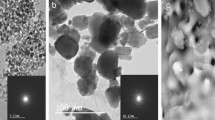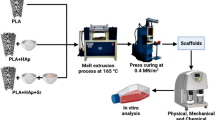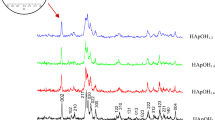Abstract
Nanocrystalline calcium phosphate apatites are biomimetic compounds analogous to bone mineral and are at the origin of the bioactivity of most biomaterials used as bone substitutes. Their unique surface reactivity originates from the presence of a hydrated layer containing labile ions (mostly divalent ones). So the setup of 3D biocompatible apatite-based bioceramics exhibiting a high reactivity requests the development of «low» temperature consolidation processes such as spark plasma sintering (SPS), in order to preserve the characteristics of the hydrated nanocrystals. However, mechanical performances may still need to be improved for such nanocrystalline apatite bioceramics, especially in view of load-bearing applications. The reinforcement by association with biopolymers represents an appealing approach, while preserving the advantageous biological properties of biomimetic apatites. Herein, we report the preparation of composites based on biomimetic apatite associated with various quantities of microcrystalline cellulose (MCC, 1–20 wt%), a natural fibrous polymer. The SPS-consolidated composites were analyzed from both physicochemical (X-ray diffraction, Fourier transform infrared, solid state NMR) and mechanical (Brazilian test) viewpoints. The preservation of the physicochemical characteristics of apatite and cellulose in the final material was observed. Mechanical properties of the composite materials were found to be directly related to the polymer/apatite ratios and a maximum crushing strength was reached for 10 wt% of MCC.
Graphical Abstract









Similar content being viewed by others
References
Billotte WG. Ceramic biomaterials. In: Park JB, Bronzino JD, editors. Biomaterials principles and applications. Boca Raton: CRC Press; 2003. p. 21–54.
Heness G, Ben-Nissan B. Innovative bioceramics. Mater Forum. 2004;27:104–14.
Eichert D. Etude de la réactivité de surface d’apatites de synthèse nanocristallines. PhD thesis, INP Toulouse, 2001.
Cazalbou S, Eichert D, Ranz X, Drouet C, Combes C, Harmand MF, Rey C. Ion exchanges in apatites for biomedical application. J Mater Sci. 2005;16:405–9.
Grossin D, Rollin-Martinet S, Estournes C, Rossignol F, Champion E, Combes C, Rey C, Chevallier G, Drouet C. Biomimetic apatite sintered at very low temperature by spark plasma sintering: physico-chemistry and microstructure aspects. Acta Biomater. 2010;6:577–85.
Drouet C, Bosc F, Banu M, Largeot C, Combes C, Dechambre G, Estournes C, Raimbeaux G, Rey C. Nanocrystalline apatites: from powders to biomaterials. Powder Technol. 2009;190:118–22.
Mano JF, Sousa RA, Boesel LF, Neves NM, Reis RL. Bioinert, biodegradable and injectable polymeric matrix composites for hard tissue replacement: state of the art and recent developments. Compos Sci Technol. 2004;64:789–817.
Tobyn M, McCarthy GP, Staniforth JN, Edge S. Physicochemical comparison between microcrystalline cellulose and silicified microcrystalline cellulose. Int J Pharm. 1998;169:183–94.
Kiziltas A, Gardner DJ, Han Y, Yang H-S. Dynamic mechanical behavior and thermal properties of microcrystalline cellulose (MCC)-filled nylon 6 composites. Thermochim Acta. 2011;519:38–43.
Adel AM, El-Wahab ZHA, Ibrahim AA, Al-Shemy MT. Characterization of microcrystalline cellulose prepared from lignocellulosic materials. Part II: physicochemical properties. Carbohydr Polym. 2011;83:676–87.
Vandecandelaere N, Rey C, Drouet C. Biomimetic apatite-based biomaterials: on the critical impact of synthesis and post-synthesis parameters. J Mater Sci. 2012;23:2593–606.
Elliott C. Structure and chemistry of the apatites and other calcium orthophosphates, studies in inorganic chemistry, vol. 18. Amsterdam: Elsevier; 1994. p. 288.
Kolodziejski W. Solid-state NMR studies of bones. Top Curr Chem. 2004;246:235–70.
Eichert D, Drouet C, Sfihi H, Rey C, Combes C. Nanocrystalline apatite-based biomaterials: synthesis, processing and characterization. In: Kendall JB, editor. Biomaterials research advances. New York: Nova Science Publishers; 2007. p. 93–143.
Bradley JV, Bridgland LN, Colyer DE, Duer MJ, Friscic T, Gallagher JR, Reid DG, Skepper JN, Trasler CM. NMR of biopolymer-apatite composites: developing a model of the molecular structure of the mineral-matrix interface in calcium phosphate biomaterials. Chem Mater. 2010;22:6109–16.
Rojas J, Lopez A, Guisao S, Ortiz C. Evaluation of several microcrystalline celluloses obtained from agricultural by-products. J Adv Pharm Technol Res. 2011;2:144–50.
Atalla RH, Gast JC, Sindorf DW, Bartuska JC, Maciel GE. Carbon-13 NMR spectra of cellulose polymorphs. J Am Chem Soc. 1980;102:3249–51.
Park S, Johnson DK, Ishikawa CI, Parilla PA, Davis MF. Measuring the crystallinity index of cellulose by solid state 13C nuclear magnetic resonance. Cellulose. 2009;16:641–7.
Isogai A, Usuda M, Kato T, Uryu T, Atalla RH. Solid-state CP/MAS carbon-13 NMR study of cellulose polymorphs. Macromolecules. 1989;22:3168–72.
Idstrom A, Brelid H, Nydén M, Nordstierna L. CP/MAS 13C NMR study of pulp hornification using nanocrystalline cellulose as a model system. Carbohydr Polym. 2013;92:881–4.
Jaeger C, Groom NS, Bowe EA, Horner A, Davies ME, Murray RC, Duer MJ. Investigation of the nature of the protein-mineral interface in bone by solid-state NMR. Chem Mater. 2005;17:3059–61.
Nikel O, Laurencin D, Bonhomme C, Sroga GE, Besdo S, Lorenz A, Vashishth D. Solid state NMR investigation of intact human bone quality: balancing issues and insight into the structure at the organic-mineral interface. J Phys Chem C. 2012;116:6320–31.
Nikel O, Laurencin D, McCallum SA, Gundberg CM, Vashishth D. NMR investigation of the role of osteocalcin and osteopontin at the organic–inorganic interface in bone. Langmuir. 2013;29:13873–82.
Bonhomme C, Gervais C, Laurencin D. Recent NMR developments applied to organic–inorganic materials. Prog Nucl Magn Reson Spectrosc. 2014;77:1–48.
Acknowledgments
This research was partly funded by the French National Research Agency (ANR) through the NanoBioCer Project (ANR-07-BLAN-0373). We are grateful to Makram EL-BACHAWATI for the preliminary studies of this work.
Author information
Authors and Affiliations
Corresponding author
Electronic supplementary material
Below is the link to the electronic supplementary material.
10856_2015_5553_MOESM1_ESM.pdf
Supplementary material 1 (PDF 86 kb). Supplementary Materials in Online Ressource. Additional analyses of 1H → 31P CPMAS solid state NMR spectra (Figure S1)
Rights and permissions
About this article
Cite this article
Brouillet, F., Laurencin, D., Grossin, D. et al. Biomimetic apatite-based composite materials obtained by spark plasma sintering (SPS): physicochemical and mechanical characterizations. J Mater Sci: Mater Med 26, 223 (2015). https://doi.org/10.1007/s10856-015-5553-9
Received:
Accepted:
Published:
DOI: https://doi.org/10.1007/s10856-015-5553-9




